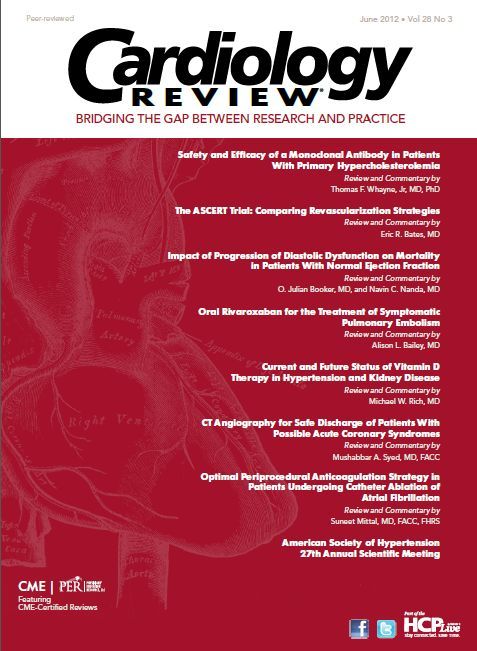Publication
Article
Cardiology Review® Online
The ASCERT Trial: Comparing Revascularization Strategies

Eric R. Bates, MD
Review
Weintraub WS, Grau-Sepulveda MV, Weiss JM, et al. Comparative effectiveness of revascularization

strategies. N Engl J Med. 2012;366:1467-1476.
P
ercutaneous coronary intervention (PCI) and coronary artery bypass graft surgery (CABG) for patients with stable ischemic heart disease (SIHD) are revascularization strategies that have been in competition for over 25 years. A dozen randomized trials have compared them for revascularization efficacy and many more observational
reports have evaluated the 2 types of procedures for revascularization effectiveness. It has previously been established that PCI does not reduce the risk of death or myocardial infarction (MI) compared with medical therapy, but that it is excellent at reducing angina pectoris and myocardial ischemia, and improving quality of life. Likewise, there is no survival advantage with CABG compared with medical therapy in patients with single- and double-vessel coronary artery disease (CAD) and in patients with normal left ventricular function. CABG accomplishes the same goals as PCI and offers more durable benefit with less need for repeat revascularization
procedures, but is associated with the complications of major surgery, more hospital days, and a longer recovery period. CABG is superior to PCI in complex triple-vessel CAD, but PCI is a comparable strategy when focal triple-vessel CAD is present.1
A strong case can be made that the only revascularization intervention in patients with SIHD that prolongs life is an internal mammary graft to the left anterior descending artery. Conversely, it is quite possible that stents will prove to be superior to saphenous vein bypass grafts that degenerate after several years and lead to major clinical challenges. Whereas cardiac surgery has made important progress in reducing perioperative stroke and MI rates, interventional cardiology has made advances in treating chronic total occlusions, bifurcation lesions, and left main stenosis. And so the debate over efficacy and effectiveness continues into its third decade.
Study Design
The American College of Cardiology Foundation (ACCF) and the Society for Thoracic Surgery (STS) have established important national data registries for PCI and CABG. The NHLBI-funded ASCERT (ACCF and STS Database Collaboration on the Comparative Effectiveness of Revascularization Strategies) study linked hospital data from the 2 registries collected from 2004 through 2007 to claims data from the Centers for Medicare & Medicaid Services to analyze long-term mortality, re-hospitalization,
and resource utilization outcomes. 2,3 Among patients older than 64 years with double- or triple-vessel CAD, 86,244 underwent CABG and 103,549 underwent PCI. The median follow-up period was 2.67 years. The mean age was 74 years, 36% had diabetes mellitus, 84% had hypertension, 16% had cerebrovascular disease, and 16% had peripheral artery disease. Curiously, 26% were asymptomatic and the mean left ventricular ejection fraction was normal at 54%. Importantly, triple-vessel disease was present in 80% of patients undergoing CABG, but in only 32% of patients undergoing PCI, confirming that treatment decisions were made on divergent clinical profiles. At 1 year, there was no difference in adjusted mortality rates, but at 4 years there was lower mortality with CABG than with PCI (16.4% versus 20.8%; risk ratio, 0.79; 95% CI, 0.76-0.82). Many more reports are expected from this collaboration in the next few years.
References
1. Kappetein AP, Feldman TE, Mack MJ, et al. Comparison of coronary bypass surgery with drug-eluting stenting for the treatment of left main and/or three-vessel disease: 3-year follow-up of the SYNTAX trial. Eur Heart J. 2011;32:2125-2134.
2. Klein LW, Edwards FH, DeLong ER, Ritzenthaler L, Dangas GD, Weintraub WS. ASCERT: The American College of Cardiology Foundation—The Society of Thoracic
Surgeons Collaboration on the Comparative Effectiveness of Revascularization Strategies. J Am Coll Cardiol Interv. 2010;3:124-126.
3. Weintraub WS, Grau-Sepulveda MV, Weiss JM, et al. Comparative effectiveness of revascularization strategies. N Engl J Med. 2012;366:1467-1476.
4. Hlatky MA, Boothroyd DB, Bravata DM, et al. Coronary artery bypass surgery compared with percutaneous coronary interventions for multivessel disease: a collaborative analysis of individual patient data from ten randomised trials. Lancet. 2009;373:1190-1197.
Commentary
Comparative Effectiveness of Revascularization Strategies
A
lthough this report is the largest to date on revascularization outcomes in elderly US patients and is a statistical tour de force, it has the limitations of retrospective observational research. It should be noted that the CathPCI Registry and the Adult Cardiac Surgery Database were designed as outcome-based quality improvement programs to identify and close gaps in quality of care, to reduce wasteful and inefficient care variations, and to implement effective, continuous quality improvement processes. They were not designed to do comparative effectiveness research on revascularization procedures, which is one reason why the case report forms
were different in the 2 registries, and important data were missing for this type of analysis. Not surprisingly, baseline characteristics differed substantially, so propensity scores and inverse-probability-weighting were applied in an attempt to adjust for those differences and missing data. Of note, the patients were not matched for coronary anatomy or left ventricular function, the primary determinants in choosing a revascularization strategy.
It is important to remember several points. First, patients in randomized trials are carefully selected, are often fewer than 10% to 20% of screened patients, and do not benefit from individual patient/physician choice of therapy. Second, patients in observational trials are studied after treatment decisions have already been made by patient need or physician preference, so treatment selection bias and unmeasured confounders are major limitations that cannot be completely overcome by statistical manipulations. Third, missing or misclassified data in registries, and particularly in claims-based registries, limit data quality. Whereas randomized trials are criticized for not being generalizable and observational database reports increasingly claim they better represent real-world practice, both can only give background support to complex clinical decision making that is unique to each patient.
The ACCF Clinical Practice Guidelines and the Appropriate Use Criteria already summarize how best to offer revascularization procedures to patients with SIHD. Those
with single- or double-vessel CAD (particularly in the circumflex and right coronary arteries), discrete lesions, and normal left ventricular function do very well with PCI.
CABG is usually preferred for complex triple-vessel CAD, especially when chronic total occlusions are present in the distribution of viable myocardium. Clinically, CABG is less attractive in younger patients who have increased risk for developing saphenous vein graft disease and requiring a second operation in the future. More important, a metaanalysis with 7812 patients did not show a statistically significant survival benefit with CABG,4 so patient-centered revascularization decisions can be made individually after multiple clinical factors have been considered. That is the concept behind the heart care team making a consensus decision with the patient after a careful review of all the risks and benefits associated with coronary revascularization. As PCI technology has improved, it is also important to note that there are now high-risk patients deemed inoperable who are increasingly being referred for PCI by cardiac surgeons.
Comparative effectiveness research is an important national priority. However, if comparative effectiveness research is to be done using databases, then the recently
established STS/ACC TVT Registry is a new standard for a prospective and collaborative effort (http://tvtregistry .org). All U.S. patients undergoing transcatheter aortic
valve replacement will be enrolled in the TVT Registry using a web-based collection tool developed by interventional cardiologists and cardiac surgeons with standardized data elements and definitions, and quality improvement tools to advance quality improvement initiatives. It is simplistic to claim that all older patients with multivessel SIHD have a survival advantage with CABG compared with PCI. Some do and some do not. As we move closer to patient-centered care, it is important to remember that all coronary revascularization decisions are complex and need to be individualized. They are grounded in randomized and observational trial data, physician and hospital capabilities, and informed decision making by the heart care team and the patient. Sometimes the best treatment decision for a particular patient is associated with a Class III recommendation from the Clinical Practice Guidelines or an “Inappropriate” designation from the Appropriate Use Criteria. Rather than continuing the professional debate on revascularization superiority, PCI and CABG should be viewed as complementary strategies and valued as equally important SIHD treatment options.
About the Author
Eric R. Bates, MD, is professor of internal medicine at the University of Michigan. Dr Bates graduated from the University of Michigan Medical School, where he trained in internal medicine and cardiology. His research efforts have focused on fibrinolytic and catheter-based reperfusion therapy for acute MI and cardiogenic shock, antiplatelet and anticoagulant therapy for coronary thrombosis, and coronary artery revascularization. He was vice-chair for the 2011 ACCF/AHA Guidelines for Percutaneous Coronary Intervention Writing Committee. He is also Chair of the Mission: Lifeline Science Task Force.
